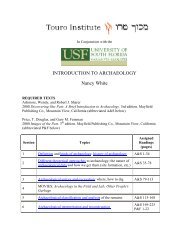In Conjunction with Cultural Anthropology - Touro Institute
In Conjunction with Cultural Anthropology - Touro Institute
In Conjunction with Cultural Anthropology - Touro Institute
Create successful ePaper yourself
Turn your PDF publications into a flip-book with our unique Google optimized e-Paper software.
9. <strong>In</strong>ternational Phonetic Alphabet<br />
19. language nationalism<br />
10. phonemic alphabet<br />
a. the study of how language is used and how the use of language conveys information<br />
about the social settings in which it is used<br />
b. the idea that language influences thought processes<br />
c. groups of related languages each of which evolved from a single, ancestral language<br />
that was spoken about five or six thousand years ago<br />
d. a system of fewer than one hundred written symbols that can be used for writing any<br />
of the world’s more than 3,000 spoken languages<br />
e. an alphabet made by using only one symbol for each phoneme of a language<br />
f. new languages that are created by groups of people who did not speak the same<br />
language when they first came together<br />
g. the words which children normally learn in their earliest years at home and use<br />
frequently in normal speaking<br />
h. a method in the 1950s to estimate the minimum number of years since the divergence<br />
of any two related languages<br />
i. prejudices concerning the elevation of one language or another to special legal status<br />
as a “national language” that is required for use in various settings<br />
j. objects or events that have no inherent significance and whose meanings exist only<br />
because their users have agreed that they will represent certain other objects or events<br />
k. the gestural language of the deaf in North America<br />
l. the largest and most recently evolved part of the brain, which monitors the senses,<br />
controls mental activities, and initiates voluntary activities<br />
m. dialects <strong>with</strong> a reputation of being inherently better than others<br />
n. a system of communication that uses both signs and symbols to communicate<br />
o. the study of language and the roles it plays in human social life<br />
p. the study of the body movements that complement speech as a means of<br />
communication<br />
q. the study of people's use of the space around them<br />
r. ancestral language from which most of the languages from Europe through <strong>In</strong>dia<br />
evolved<br />
s. mutually intelligible variants of a language shared by different social groups<br />
True/False - Chapter 5: Language and Culture<br />
True<br />
False<br />
1. A sign is a kind of symbol.<br />
2. Homo sapiens is the only species of animals that communicates.<br />
3. Nonverbal communication is composed entirely of signs.<br />
4. Language is a synonym for speech.
















